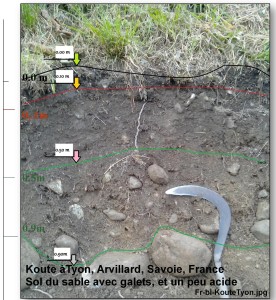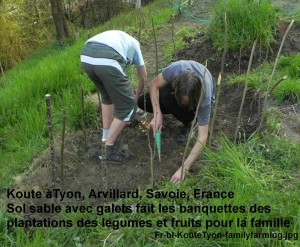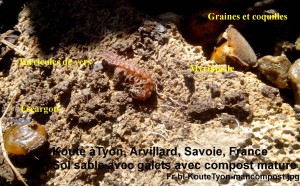Alpine hillside soil, sandy and with pebbles, Koute a Tyon, Arvillard (little village in the Northern Alps), La Chavanne, Savoie, France
“Our managements allowed us to largely limit the challenges that were out of our control.”

 Description: A deep well-drained slightly acidic soil, full of sand and pebbles from the Belladonna Massif.
Description: A deep well-drained slightly acidic soil, full of sand and pebbles from the Belladonna Massif.
The soil profile has a succession of true horizons down to 1 metre deep:
Horizon 1 Layer of plant and decaying matter rich in plant litter (from reaping, leaves, branches, mosses), lichens, moulds and mushroom mycelium.
Horizon 2 : Organic-mineral sand layer containing some small round pebbles (up to 5 cms) and sharp rock fragments. Lots of plant roots and microfauna.
There are coal remnants from ancestral fires.
 Horizon 3 Organic -minéral muddy sand layer with larger round pebbles (5-15 cms), and the roots of brambles and hazel trees.
Horizon 3 Organic -minéral muddy sand layer with larger round pebbles (5-15 cms), and the roots of brambles and hazel trees.
The yellowish color comes from silt and weathering of Arénitic sedimentary rocks (high in mica K).
Horizon 4 Mineral bed with big round pebbles (15-35 cms) in sandy –clay mixtures, and none or few roots.
Location: The slope is steep (60 %) This soil profile is midway down, in an orchard and on the edge of an area of natural forest of Belladonna Range, Savoie, northern France .
The values of our hillside soil
– gives our family healthy food,
– Helping better preserve local biodiversity, soils and plants adapted to our climate.
In the soil profile:
– Excellent drainage and infiltration though the sands and pebble bed
– Minerals from the weathering from the Arentic rock
– Fertile loams,
– Relic litter (carbon) from forested times
The big clumps in the upper layers of H1 and H2 , stabilize the slope into which we will plant vines in the future
The different sized stones in the H3 and H4 are sorted and added to other stones from Lauzes. to make into a retaining wall for the kitchen garden higher up.
– the arable sandy silts in H2 and H3 are carefully collected to improve the kitchen garden soil, growing a plot of carrots before becoming a living soil, easy to work and fresh, limited only by water in dry times.
– The leaves, broken branches and coal bits, are made into a swathe for top mulching the kitchen garden to reduce evaporation in summer in and the autumn for improving the vineyard soil with the addition of more plants and cuttings)
Our Challenges
1 Our family’s need for healthy food from our hillside
2 The real changes in the Rhône-Alpes alpine climate (local available on Météo France ). Here at Arvillard 2015 has the symptom of these changes with ;
– weak spring rain ,
– a marked heat wave in July and August
– some extreme events ( storms, rainfall…)
– and a great drought resulting in dramatic lost production in vegetables for our family .
3 Our aim to better preserve biodiversity, our soil quality and our plant production using local species or those adapted to our climate
Our managements
1 We observe our kitchen garden and our family farm « jardin de La Koute à Tyon »
2 Economic management of rain water collected in Spring by irrigation, watering…)
– planting hardier botanical species or those which are fast growing under varied shade
–preparing soils to better retain water,
3 actions which favour the biodiversity needed for good pollinisation of productive species by sheltering insects
For more
– photos of this wonderful permaculture family farm see the full pdf solde-colline-alpine-Koute-à-TyonFr (14.5 Mb) (note the text is in French and has been translated here) . This Soil Selfies en francais
– and its family farm snapshot in French or English in the French section of the family farms webpage
– For other permaculture family farm Soil Selfies (in English), visit Olambos in Kenya and an urban backyard in Melbourne, Australia .
– for a different environment and methods protecting a ‘lost’ biodiversity, visit Stanmore Gravels from England
Credits : Benjamin Lacheny, Tyon Koute, France, gives his permission for his photos and information to be shared under a CC licence 2015
Edited and translated by Jeanie Clark , enviroed4all ®, Australie, for use in education under a CC licence 2015
Visit more Soil Selfies
This page was published 4 December 2015, updated 28 January 2016
